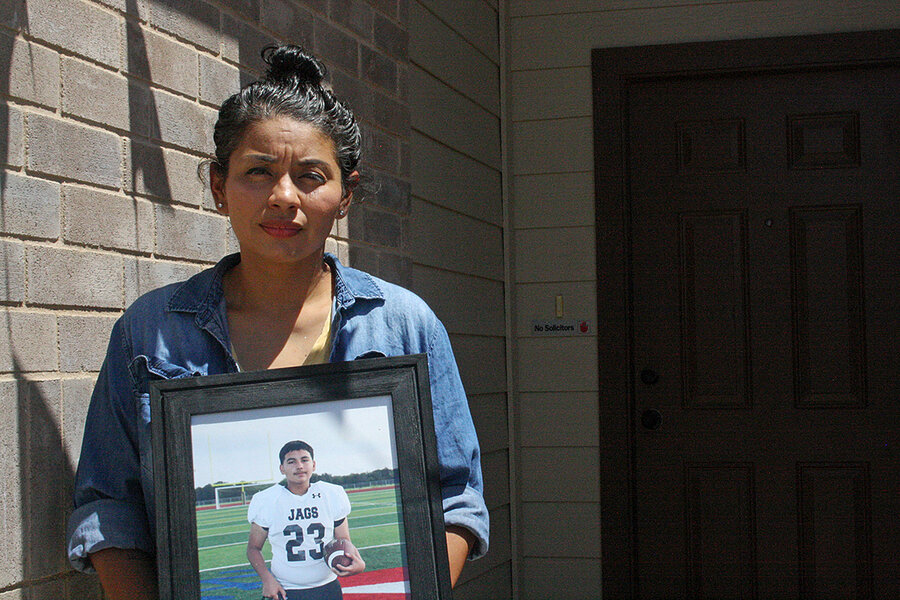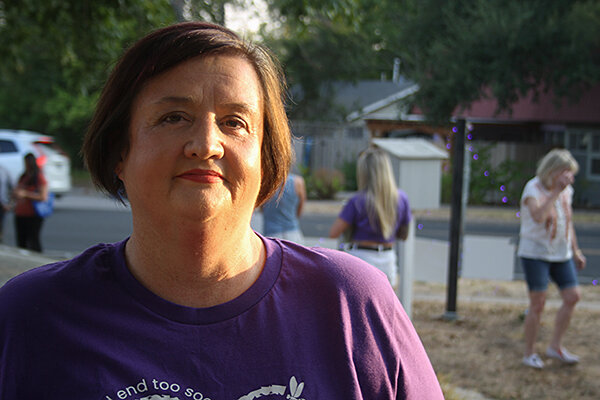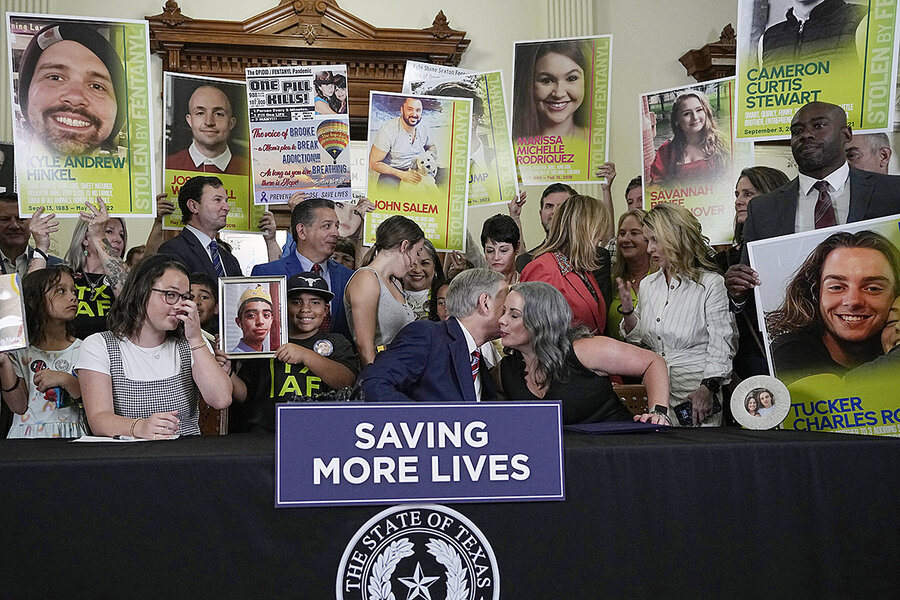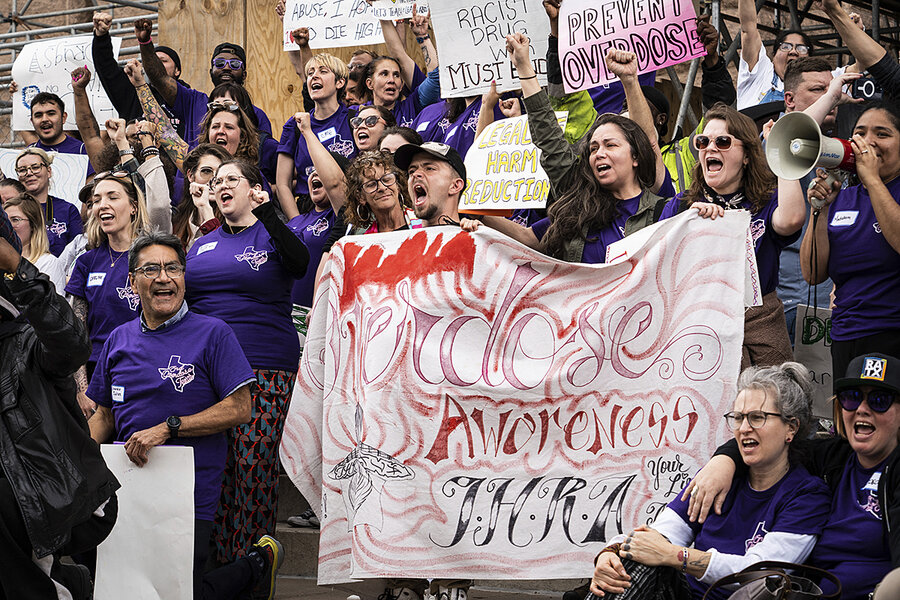In August 2022, Janel Rodriguez got a call from a mother she didn’t know. Her teenage son, Noah, had overdosed. She rushed over to the mother’s home, but she didn’t need to go inside to know her son was dead. Instead, she sank to her knees as every moment of Noah’s short life flashed before her eyes.
He’d grown from being an obedient, mild-mannered child to an angsty, troubled teen with the early wisps of a mustache. In between there had been birthday parties, vacations, and football games. He’d wanted to be an engineer, then he’d wanted to be an underwater welder. He’d never wanted to fatally overdose.
Screaming and crying, Ms. Rodriguez relived it all in seconds. She had to wait much longer to find out who had sold Noah the fentanyl-laced drugs. When she finally did, a prosecutor asked her how tough a punishment she wanted.
Why We Wrote This
A story focused on
Fentanyl is the leading cause of death for Americans ages 18 to 45. Texas is taking a largely tough-on-crime approach, while critics urge a new approach prioritizing addiction treatment and prevention.
“I was really torn,” she says. “All I could think about was his mom.”
The defendant had just turned 19. Legally he’s an adult, she thought, “but he’s still a child.” On the other hand, Noah had been one of four children to die from fentanyl overdoses in her Texas community, Hays County, since that summer. And by the next summer, two more children had died.
She spent a week sorting through her emotions, then she told the prosecutor she wanted the toughest possible sentence.
“I have to do what’s best for Hays County, and if that means putting this person away for 20 years, then that’s what I’ve got to do,” she says.

Henry Gass/The Christian Science Monitor
Janel Rodriguez holds a picture of her son, Noah, who died from a fentanyl overdose in 2022 in Buda, Texas, Sept. 5, 2023. Texas has been hit hard by the opioid crisis in the past few years, and experts worry the punitive responses the state has taken is repeating the mistakes of the war on drugs era.
In 2023, Texas leaders listened to sentiments like those of this grieving mother. Gov. Greg Abbott declared a “war on fentanyl,” and the Legislature, at his urging, passed two laws increasing criminal penalties related to the drug. Like other states, Texas is struggling with a surge in fatal overdoses from this synthetic opioid, which is considered up to 50 times stronger than heroin. Deaths from fentanyl-related overdoses in Texas more than quintupled from 317 to 1,612 between fiscal years 2019 and 2021, according to state data. Fentanyl is now the leading cause of death for Americans aged 18 to 45.
But how to stop the fatal overdoses? Critics decry the tough Texas approach as a throwback to the war on drugs, launched in the 1970s, which resulted in mass incarcerations without meaningfully addressing drug-related crime and addiction. In many ways, the opioid crisis today is more formidable and complex than America’s past drug crises. Opioids are deadlier, more addictive, easier to hide, and more manipulable than any narcotic the United States has tried to police before. Neither dealers nor users may know fentanyl is present in a drug, blurring the idea of what justice should look like.
The issue takes on added urgency as state, local, and tribal governments begin to consider how to spend upward of $50 billion coming their way over the next 18 years – the result of legal settlements with opioid manufacturers and distributors. And in November, the U.S. and China announced an agreement that would see China – a major source of precursor chemicals used to manufacture fentanyl – curtail shipments of those chemicals and share more information about suspected international drug trafficking.
But the fentanyl challenge is confounding, and states are searching for the best path forward. Even while the Lone Star State emphasizes the punitive approach, pressure is building to recognize the challenge as a public health issue – and state lawmakers have nodded in that direction. Particularly at the local level, officials are pushing for more support for addiction treatment and recovery, as well as expanding access to overdose prevention tools.
“The two opposite policy approaches are happening at the same time. And sometimes, curiously enough, in the same places,” says Magdalena Cerdá, director of the Center for Opioid Epidemiology and Policy at New York University. “If we actually want to improve things for other people, to prevent other people from dying, we need to figure out what works.”
Tough laws not stopping overdoses
America is now in the fourth wave of the opioids crisis. Texas resident Joshua Bell lived through three of them.
The Vicodin prescription doctors gave him after a 2010 car accident was “like the first time experiencing love,” he said a few years later. Like countless Americans, he became hooked on prescription opioids – the first wave. When authorities began cracking down on these prescription drugs, the second opioids breaker crashed ashore. Like so many other people, he turned to heroin.
Mr. Bell survived that second pummeling, too. He went to rehab; he got sober. When he moved to College Station, Texas, with his girlfriend, the third wave of the crisis – synthetic opioids, e.g., fentanyl – was rolling over the country, soon to be followed by the fourth wave, synthetic opioids mixed into other drugs. “He was doing really well,” says his mother, Annie Hernandez. “Until he wasn’t.”

Henry Gass/The Christian Science Monitor
Annie Hernandez stands outside the Christi Center, a grief support nonprofit, on International Overdose Awareness Day, Aug. 31, 2023, in Austin, Texas. Since her son died from a fentanyl overdose in 2019, she has been advocating for more public health resources for the opioid crisis.
One night, he bought Xanax laced with a few nanograms of fentanyl, and fatally overdosed. It was 2019, the year fentanyl became widespread in the U.S. and overdose deaths began to spike. Almost 71,000 people died from drug overdoses that year, about half from synthetic opioids, according to the U.S. Centers for Disease Control and Prevention. In 2021, the last year for which data is available, almost 107,000 died from drug overdoses, with more than two-thirds of those involving synthetic opioids.
The same trends have occurred in Texas. Last year, the state responded by increasing criminal penalties for possessing or selling fentanyl. State lawmakers also passed a law that empowers prosecutors to bring murder charges against people who sell fentanyl that leads to a fatal overdose. Similar drug-induced homicide laws are now on the books in around 30 states.
But decades of research into the war on drugs, launched by President Richard Nixon, show that tough, punitive drug policies – such as drug-related homicide laws, passed in the 1970s and ’80s – have failed to get at root causes and have had unintended, costly consequences. Meanwhile, fatal drug overdoses are increasing.
A fifth of those incarcerated in America are behind bars for drug offenses, disproportionately affecting people of color and causing long-term collateral damage to them and their families. As of 2021, the U.S. had spent over $1 trillion enforcing its drug policy, CNBC reported that year, which was the 50th anniversary of the war on drugs. Drug overdose deaths initially declined but began to rise in the 1980s, and have risen much more steeply in this century. A veteran Baltimore police officer told NPR that the drug war has “failed” and “does not belong in our wheelhouse.”
Texas lawmakers who favored increased penalties for selling fentanyl – and even for possessing it – argued that current laws don’t have enough teeth to punish high-level dealers who make millions off of street-level users. State Rep. Craig Goldman, who co-sponsored the drug-induced homicide law, told the Fort Worth Star-Telegram the intent of the law is to go after “the individuals doing this on a grand scale.”
Yet tying drug use to criminal punishment “dissuades people from seeking help” with addiction problems, perpetuating their addiction, according to the Drug Policy Alliance, an advocacy group that seeks to end the drug war.
Tough-on-crime responses are partly responsible for the rise of fentanyl, according to experts. The crackdown on the overprescribing of legal opioids in the 2010s created a demand for illicit opioids like heroin and, later, fentanyl.
“The emergence of fentanyl … is the result of missteps in how this crisis was addressed in previous years,” says Leo Beletsky, a professor at Northeastern University School of Law who researches homicide laws tied to drug overdoses.
Speaking of such laws, he says, “The reality is that prosecutions often target friends, relatives, and other people who may be present at overdose scenes.” The theory that arresting high-level dealers will prevent fatal drug overdoses “has never been [supported by] any kind of empirical evidence,” he adds.

Texas Gov. Greg Abbott (center) hugs Stephanie Turner (right) after signing fentanyl legislation bills passed by the Legislature at the Texas Capitol in Austin, June 14, 2023.
What if Noah had gone into rehab?
Entering 2022, Noah was struggling not just with pandemic schooling and teenage angst, but also with addiction issues. His mother had been noticing changes.
With schools shut down, he started hanging out with a new group of friends, coming home smelling of marijuana some nights. And in May 2022, she got a call from the local police: Noah and three friends had taken cocaine, and Noah was unresponsive. After a week in the hospital, he came home and committed to turning his life around. He apologized, telling his parents, “I don’t want to die.”
“Summer 2022 was the best summer with Noah we remember,” says Ms. Rodriguez. He continued to wrestle with drug use, but he was present and honest, and enjoyed spending time with his family, she recalls. And then came the overdose.
“I don’t regret anything I did as a parent,” she adds. “But I feel like if he was just given the chance to go into rehab, it could possibly have had a different outcome.”
In this context, it’s important to note what Texas, at the state level at least, hasn’t done. Expanding access to treatment, especially for minors, is one. A bill to legalize fentanyl test strips – which allow drug users to test if a substance is laced with fentanyl, and are legal in roughly 40 states – failed in Texas last fall despite overwhelming bipartisan support in the state House of Representatives.
The Legislature did pass a 2023 bill requiring public school campuses to be stocked with Narcan, a popular overdose-reversal medication, and the state did launch a $10 million awareness campaign last year. But the state’s continued refusal to participate in expanded Medicaid also “means fewer resources to help cover the cost of drug treatment, not to mention the many other health care needs that left untreated can increase the risk of drug use and addiction,” says Katharine Neill Harris, a drug policy expert at Rice University’s Baker Institute for Public Policy.
This environment makes it difficult for Texas to widely adopt what are known as “harm reduction” practices. As criminalization has failed to protect people from drug overdoses – and as the decriminalization of drug use in places such as Oregon has, so far, not reduced overdose deaths either – harm reduction approaches seek to make drug use as safe as possible, preventing overdoses in the short term while helping people get clean in the long term.
These approaches, such as making overdose reversal medications, drug-checking technologies, and syringe services more available, do have significant public health benefits, according to the National Institute on Drug Abuse.

Sara Diggins/Austin American-Statesman/AP/File
People from the Texas Harm Reduction Alliance as well as rallygoers gather at the Texas State Capitol in Austin Feb. 15, 2023, to demand lawmakers address the overdose crisis in Texas, legalize fentanyl test strips, and put in place other harm reduction measures.
“We just haven’t addressed the demand for drugs. We’re just not doing that the way we should be,” says Dr. Neill Harris. That’s why harm reduction is so important, she says.
“All these structural problems that make people feel like their lives aren’t worth living … those problems we’re just not dealing with,” she adds. “And because we’re not dealing with that, we should be trying to make drug use less harmful for people who do use drugs.”
A two-pronged approach
While Texas has favored a mostly law enforcement response to the opioid crisis, those tasked with enforcing that response acknowledge they’re in a tricky position: Fentanyl is illegal, and a threat to public safety, but the underlying addiction problems in society are public health issues.
What are prosecutors, for example, to do?
The county with the most fentanyl-related overdose deaths in Texas through the first half of 2023 – Harris County, home to Houston – is trying a two-pronged strategy.
Last spring the Harris County district attorney’s office added fentanyl-related overdose deaths to its caseload. The agency’s major narcotics unit works with local law enforcement and the U.S. Drug Enforcement Administration on major fentanyl trafficking cases.
“We’ve kind of had to add one more hat that we wear,” says Garrett Moore, chief of the narcotics section in the district attorney’s office.
What Mr. Moore’s office does not handle, however, are low-level fentanyl possession cases. Those cases are automatically diverted to the Responsive Interventions for Change court. Founded in 2016, the specialty court aims to connect defendants to treatment and resources instead of locking them up. Since its creation, the county has seen the recidivism rate for high-risk defendants drop from 60% to 32%, according to the district attorney’s office. The court has also helped lower the number of people being held by the overwhelmed county jail system.
The diversion effort is being replicated in “a lot of places” outside of Texas, says Dr. Neill Harris. “It’s not a silver bullet, but it’s better than incarcerating people.”
Historically, incarceration is what followed the enhancement of criminal penalties. Crack cocaine laws in the 1980s and ’90s, for example, carried heavy punishments for simply possessing the substance – penalizing users as much as dealers, and causing the incarceration rate of Black Americans to explode.
Drug-induced homicide laws have existed for decades as well, including for crack cocaine, but the Texas fentanyl law has an important update: focusing on selling instead of possessing.
In the fentanyl context, specific dealers can be dangerous. Fentanyl cases often involve a rash of fatal overdoses connected to a single dealer, such as two in the Dallas area last year who were allegedly tied to 10 overdoses, three of them fatal.
“If [a] dealer starts slinging fentanyl without telling people, or has a bad mix, you might get several overdoses out of it,” says Mr. Moore. “If these people are not prosecuted, they will continue to sell fentanyl.”
At the same time, buyers often don’t know they’re buying fentanyl, and dealers may not know either. Someone who buys a fentanyl-laced drug to take with friends may face murder charges if a friend dies from an overdose, as happened last year with a teenage girl in Tennessee.
For this reason, Mr. Moore hopes that prosecutors in the state will be selective in how and when they pursue the harshest punishments.
“We all need to be on board with the fact that the prison system is probably not the best place to try to treat people when their underlying issue is not a criminal issue, but a substance abuse issue,” he adds.
Prosecutorial discretion “becomes super important,” he continues, “so that we’re not recreating the crack epidemic in the ’80s for people who really need help.”
>>> Read full article>>>
Copyright for syndicated content belongs to the linked Source : The Christian Science Monitor – https://www.csmonitor.com/USA/2024/0110/Will-Texas-tough-work-in-fighting-fentanyl-fatalities?icid=rss






























